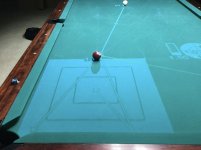Lotta gobbledegook here. I like to keep it simple. The dwell time between tip and cueball is 1/1000 of a second...or a quarter of an eye blink! You cannot signifcantly increase (or decrease) that dwell time, regardless of how you try (an increase from 1/1000th to 2/1000's because of a possibly softer tip, while appearing to be "statistically significant" is not so when it comes to real time on the table). A good instructor (one who uses video analysis) can help a student develop their own personal timing and rhythm. The are not imaginary ; they are definitely individual (although many players will utilize the same kind of timing and rhythm), and can be developed and fine-tuned, in order to strengthen your setup and delivery process! Here's the ultimate truth...everybody backswings too fast, and everybody shoots too hard. :grin:
Scott Lee
2019 PBIA Instructor of the Year
Director, SPF National Pool School Tour
Scott Lee
2019 PBIA Instructor of the Year
Director, SPF National Pool School Tour
Barry Stark posted a video on timing. He used a 35000 fps camera to show that timing exists.
https://youtu.be/zH2PHaGl8Ik
Barry defines it as maintaining tip to surface contact longer at impact. Many pros describe it as more of a push. My sense of timing with soft draw fits that description. On certain shots with follow I use a similar stroke which has a feel of grabbing or holding contact. Ronnie O’Sullivan and Stephen Lee call the feel “bite on the ball”. One of the ways to maintain longer contact is through a downward angled stroke.
To those out there that think you can’t feel a 200 microsecond difference in contact time, Stark’s research proves it. The shooter was asked to tell when he felt the longer contact. When compared to shots where it was missing they found that extended contact on film. Scientists have discovered that the fingertips on a human hand can differentiate thickness changes of one molecule. The tips have pressure and shape sensing abilities. Vibratory feedback distinguishes between the moment of initial contact and recognizes a longer gripping time on the surface.
In Ronnie O’Sullivan’s recent WSC win, he talked several times about the timing of his stroke. He took extra practice time pre-session to work on finding the penetrating feel of the stroke through the ball, timing.
Ronnie and Stephen both speak about maintaining the same pace on most stroke. They both speak about a timed squeeze through the ball and that height of contact and the timing of the squeeze are what give them cue ball pace control on most shots. This is a different level of timing. Squeezing can slow the cue incrementally. Timed right the shooter now knows subconsciously when to push through fully to compensate for the retarding of power. Longer contact actually translates to more actual contact follow through. That means more rotational force on off center contacts. It also lessens deflection. The driving force of the extended contact keeps it on line longer. It’s like the timed spin of pitchers, tennis players and bowlers.
On a normal contact of tip to ball, the tip decelerates from meeting resistance. Conversely, a cue executing a push type of action, drives the tip and ball forward, without a rebound effect.
To get a sense of the feel shoot over a ball. Put the cue ball a full ball away from the intervening ball. Feel the resistance of the table due to the downward angle of the cue. That is extended contact. Increase the angle slightly and hit off center to get a swerve effect. The longer contact swerves more than the lower resistance of a horizontal contact with the same off center contact point and pace.
Last edited:
